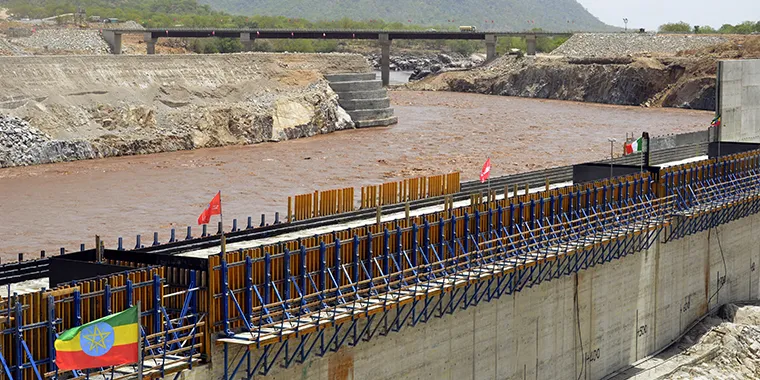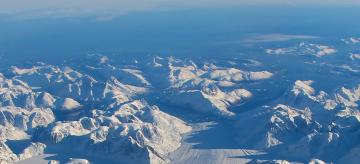What Is Water Scarcity?
Is there a global water crisis? In this free resource, learn how climate change is causing water scarcity to worsen worldwide.
On June 1, 2020, Egyptian hackers infiltrated twelve Ethiopian government websites. As part of the group’s attack, the websites displayed a dire warning: “If the river’s level drops, let all the Pharaoh’s soldiers hurry.”
The referenced river was the Nile, which Ethiopian leaders have for years worked to partially dam in order to generate hydroelectric energy. But why would hackers get so up in arms over an infrastructure project?
The answer has to do with an ancient problem: water scarcity. Egyptians fear Ethiopia’s dam will diminish Egypt’s clean water supply, and they’re not alone in their concerns over access to this life-sustaining and increasingly limited resource.
This resource explores the origins of water scarcity, the stakes of the problem, and possible solutions.
What is water scarcity?
Over one billion people worldwide experience year-round water scarcity—defined as a lack of sufficient clean water to meet daily demands—and almost three billion lack regular water access for at least one month of the year. Experts project that this problem will only worsen as the world’s population grows and climate change becomes more severe.
What is causing water scarcity?
It’s hard to think of water as scarce when you look at a world map dominated by blue. But most of that water—97 percent—is salt water and therefore not potable (drinkable). Of the remaining 3 percent fresh water, only about one-third is readily accessible. The rest is locked away in glaciers or ice caps. To paraphrase the poet Samuel Taylor Coleridge: “Water, water, everywhere, and not a drop to drink.”
Even so, the world’s water supply is large enough to meet the needs of all the planet’s inhabitants. It’s just not evenly distributed. Some regions are wetter than others; think of how certain countries have rainforests while others have deserts. However, experts say that difficulty accessing drinking water usually boils down to a lack of infrastructure rather than a lack of rainfall or other water in the environment.
Take the Democratic Republic of Congo, for instance. More than half of Africa’s water reserves sit within Congo’s borders, but infrastructure issues and resource mismanagement are common. As a result, more than thirty-three million people—over one-third of the country’s population—lack adequate access to water.
How does climate change affect water scarcity?
Climate change is poised to make these matters worse. As the planet warms, the atmosphere expands, enabling the air to suck up and retain more moisture during the evaporation stage of the water cycle. The result: arid regions will get drier and drier over time.
Meanwhile, climate change has already decreased the global potable water supply. This has occurred at a time when demand for water has skyrocketed due to a growing global population.
Climate change affects water supply in many ways. It has led to longer droughts and resulted in more natural disasters, which threaten the infrastructures that deliver clean water. Meanwhile, global warming has dried up water sources and helped pathogens thrive in (and contaminate) fresh water. Rising sea levels, driven by climate change, also make fresh water salty (or salinated) and undrinkable.
The effects of climate change and water scarcity are evident in California. There, water scarcity has mostly taken the form of droughts. These protracted arid periods have increased the risks and severity of wildfires in recent years. In 2020 alone, wildfires displaced nearly two hundred thousand Californians. These disasters disproportionately affect low-income communities—people who can’t afford to leave their homes or hire private firefighters.
How does water scarcity affect people?
Water scarcity affects every aspect of life. For instance, people in water-scarce communities often have to spend extra money to buy bottled water to cook and shower or travel for hours to access clean water. This lost time has a cost; research suggests the global economy loses $260 billion every year due to inadequate access to clean water and sanitation.
In this way, the consequences of local water scarcity can quickly become global challenges. Let’s explore a few examples:
Heightens risk of illness: For millions of children around the globe, water scarcity means they cannot turn on the tap to access clean, safe, and drinkable water. And their exposure to unclean or unsafe water raises their risk of contracting diseases like diarrhea, which kills more than eighty-five thousand children per year.
Threatens urban life: To access clean water, communities require basic infrastructure—especially in cities, where a growing share of the global population lives. However, in many cities around the globe, this infrastructure is crumbling or obsolete. The United States loses six billion gallons of clean drinking water every day due to decades-old leaky pipes.
Endangers rural economies: Farming needs a lot of water—it currently accounts for about 70 percent of all water humans use globally. (As this water helps grow the global food supply, humans actually “eat” much more water than they drink.) Climate change has already made crops less productive, and longer droughts have forced farmers to buy more water rather than rely on rain. This trend has increased farming costs and decreased the water supply for everyone else. It can also lead to higher food prices.
Water scarcity also threatens farmers’ livelihoods. For instance, in 2017 Cape Town, South Africa, almost entirely ran out of water. To avoid the crisis, city officials reallocated water from the agricultural sector, leaving farmers without the resources necessary to sustain their crops. Although the move helped save the city from running out of water, it also contributed to the loss of thirty thousand farming jobs.
Perpetuates conflict: For as long as history has been recorded, conflicts over water have occurred. For example, surviving records from 650 BCE tell the story of an Assyrian king who dried up an enemy’s wells to starve them of water.
More recently, as access to water around the world deteriorates, water-related violence has escalated both between and within countries. Throughout Yemen’s seven-year civil war, for example, both government forces and rebel groups have targeted their enemies’ water infrastructure, including dams, reservoirs, and freshwater pipes. These attacks take place in what is already one of the world’s most water-scarce places.
What are solutions to water scarcity?
Although the issue of water scarcity can be daunting, solutions exist. Let’s break down a few:
Desalination: Desalination removes salt and other minerals from seawater, evaporating salt components and leaving behind clean and drinkable fresh water. Sailors have used this technique for hundreds of years, but only recently have countries—including the United States, Australia, Israel, and Saudi Arabia—invested in large-scale desalination plants. For example, between 2009 and 2012, Australia spent $3.5 billion to build a desalination plant in Melbourne, which now provides about one-third of the city’s water supply. Although these plants are promising, they remain expensive to build and energy-intensive to operate. However, experts predict costs will decline in the future.
Filtration: One reason water is scarce is because so many sources of it have become contaminated with harmful chemicals. That’s why water filtration, which removes unsafe bacteria from fresh water, can be an effective tool. Chicago provides safe tap water for the city’s residents through a treatment process that removes harmful pollutants from water in nearby Lake Michigan. Individuals can also filter concerning chemicals from their water supply with relatively inexpensive household filtration devices.
Recycling wastewater: Some water-scarce communities have begun recycling their wastewater. This process involves treating municipal sewage to rid it of bacteria and then reusing wastewater for toilet flushing and irrigation systems, among other purposes. Orange County, California has mitigated its drought risk by recycling more than 250 billion gallons of water.
Drip irrigation: Many farmers water their crops by entirely flooding a field or using far-reaching sprinklers. These methods, however, can waste substantial amounts of water. Drip irrigation, on the other hand, involves watering crops by targeting roots with small amounts of water—a process that saves water while maximizing crop yields. As of 2015, approximately 9 percent of the United States’ irrigated farmland was using drip irrigation.
So what's next for the global water crisis?
Clean water is a source of life, but shortages can be a source of conflict. And as our demand for clean water rises and the amount of clean water dwindles, our relationship with this precious resource will likely become more complex.
Various solutions can mitigate water scarcity—but to really address this problem, the world will have to tackle the challenge of climate change head on.



